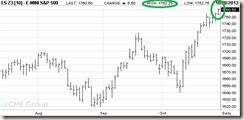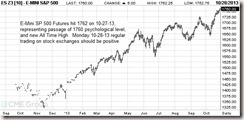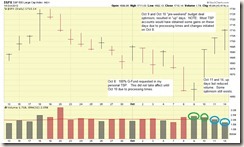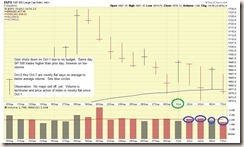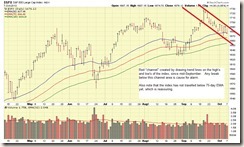The first full market week, post-Govt shutdown / post-debt ceiling crisis, is behind us, and the indexes closed out the week with gains. The SP 500 is at All Time Highs, which is a good thing, as highs indicate strength, and good health, for the underlying index or stock. The 1760 level on the SP 500 is psychologically the next important level, which represents the next 52-week high.
While we have had some naysayers in the press, it is my opinion that the indexes will continue to go up, and opinion or not, I simply react to what the market is doing. With that said, please take a look at this May 24 2013 article which appeared in CNN Money, regarding some money mangers who believe a pending “market crash” of 20% or more will happen. It should be noted that on May 24, the SP 500 index closed at 1649.60.
On today’s date, October 25, the SP 500 index closed at 1759.77, representing a 6.5% positive increase since that article. Time to turn off the “professional” money manager opinions and news media, and listen to the market itself.
With that said, I got some great subscriber emails this week and I appreciate the positive feedback, thank you. I had a few emails regarding “buying on dips” versus immediately returning to S-Fund, because that means we are “buying at a higher price” if we buy when the trend resumes upward. These are legit questions and indicate that many are taking the time to actively manage their TSP. Before I go further, let me pause and say that there are over 14,000 mutual funds in the United States with combined assets of $13 trillion, according to the Investment Company Institute (ICI), a trade association of investment companies in the United States, per Wikipedia (if you believe Wikipedia…). So obviously there is more than one way to slice bread, if $13 trillion is out there invested in so many funds, some with poor returns, some with great returns. Additionally, we have a few TSP trading websites out there, all with their own strategies. That being said, folks should do what they are most comfortable with, and use a strategy that fits them, provided by a source that they feel at ease with. Now, on to my example as to why “buying on dips” is not a strategy I recommend. I will use Enron stock as an example. Enron is somewhat of an extreme example but it will help illustrate why buying on dips is not a sound strategy (not to mention that “dips” are only visible after they happen, nobody can predict a “dip”). Lets take a look at the Enron stock chart. Disregard the blue horizontal lines on the left, as I pulled this chart from another site, and then modified it for my own use. I am not bright enough to figure out how to edit those blue lines so I just left them. My comments are on the right side of the chart. Read the comments next to the red circles that I have placed on the chart. Our imaginary investor has observed Enron make a heck of a run-up and wants to wait for a “dip” before he buys it. Follow my comments on the right side of the chart.
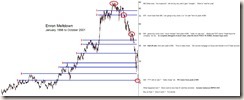
As you digest the above chart, lets go back in time (like watching video tape of a train wreck) and take a look at the Enron forum over at Motley Fool, dated 2001. The link is here, and the screen capture is below. Look at the remarks by username TBIRDMC
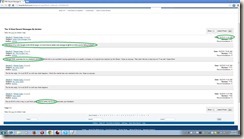
Again, Enron is an extreme example, but it serves to drive my point home that (in my opinion anyway…) buying on dips is not a sound strategy. Now, should a stock or index fall to the 50-day moving average line, and start to go flat, this is a common area where people purchase shares or accumulate additional shares, however this is part of a larger overall strategy versus waiting for “dips” because the stock is “cheaper” to buy. Stocks are cheap for a reason. GOOG (Google) is $1000 for a reason. AAPL (Apple) is $500 for a reason. In contrast, DELL is $13 (anybody enjoyed the Dell customer experience, with their spam ware/adware bloated laptops?). Vonage VOIP stock is $3 (with Skype, Facetime, local cable internet bundled VOIP packages, and other services now in the marketplace), for a reason.
Stocks and Indexes (well, any investment vehicle, be it baseball cards, antique cars, real estate, etc.) go up and go down for a reason. It is my goal to not identify the reason (contrary to popular belief, the reason does not make us money and I could care less “why” something goes up or down, just that it does), it is to identify the movement or trend, as early as possible, and get in sync with that trend. Note that entire departments of Ivy League schools, units of federal agencies, and private research groups, spend their entire waking hours trying to find out reasons, when they would be much wealthier if they instead sought out trends. I can take 10 years worth of weather data regarding August weather in Florida, hard, existing, documented data, and make the assessment that it will probably rain most of the month and thus require that I carry an umbrella in the car. By using data, I have identified a trend of behavior (regarding August Florida rain). Now, how successful would I be if I sampled the air each day, beginning August 1, and carefully analyzed it, and then researched it, sent it out to committee, then voted, on whether I should have an umbrella that month. Heck, by the time all my research came back I would have been rained on already and missed the trend. Do I care why it is raining ? All I care is “Do I need to keep an umbrella in the car”. Nothing more. What strategy makes more sense to reach this decision ?
Of the stocks discussed above, if you were given the instructions, “Vonage or Apple, make one investment and if your choice outperforms the other stock , you will win a prize” which one are you buying ? Vonage because it is “cheap”, or Apple ? Remember, Apple is 500 bucks a share. Kind of “expensive”.
Which one do you think will outperform the other ?
That folks, is the question we must ask everyday as part of a successful investment strategy, and buying “cheap” or “on dips” is not (my opinion) not part of that. Additional commentary on my March 31 2013 post.
With that said, it is my opinion that the market should continue its uptrend, as I see no red flags indicating otherwise. I am still 100% S-Fund and cannot quite put my finger on the next best performer, as I-Fund and C-Fund are basically doing equally as well, however, not as well as the S-Fund, based on my analysis going back multiple weeks. As we get more clarity on things, I will remain 100% S-Fund for the time being.
Thank you for reading and if the site/email updates are informative or useful, please share them with your friends and colleagues.
Take care…
– Bill Pritchard

